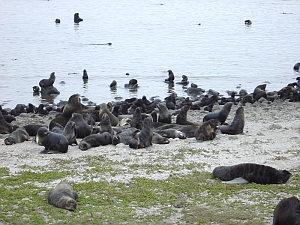From guidebook 'The Russian Far East" by Erik Azulay, Allegra Harris Azulay. 1995.
"EHTO STRANNOE MESTO..." KOMANDORSKY ISLANDS
 The Komandorsky Islands lie to the east of the peninsula. This small group of islands was "discovered" by Bering in 1741 when his ship, the St. Peter, was trying to find its way back to Kamchatka after exploring the coast of Alaska. Bering landed and wintered on the largest island, hoping to recuperate and set off again in the spring. However, it was not to be and Bering, along with many of his crew, succumbed to scurvy and died on this distant island which now bears his name. The Komandorsky Islands lie to the east of the peninsula. This small group of islands was "discovered" by Bering in 1741 when his ship, the St. Peter, was trying to find its way back to Kamchatka after exploring the coast of Alaska. Bering landed and wintered on the largest island, hoping to recuperate and set off again in the spring. However, it was not to be and Bering, along with many of his crew, succumbed to scurvy and died on this distant island which now bears his name.
When first discovered, the islands were uninhabited by man, populated only by native foxes, sea lions, sea otters, the flightless cormorant, and even the sea cow. Nowadays the foxes and sea lions are still around, but the flightless cormorant and sea cow have become extinct. In the late 1800's the animal population was increased by a reindeer herd imported by the Polish naturalist Dybovski. The main village, Nikolskoe, was founded in 1826 when the Russian-American company worked the islands, hunting whales, seals and sea otters. Competing companies also hunted the waters, and such was the demand for otter skins that each company would kill as many as possible, regardless of age or sex, in order to fill their holds as quickly as possible and sell their harvest. The result was obvious: the sea cows were hunted out of existence and the seal and otter populations dropped drastically. In 1871 exclusive rights to the islands for 20 years were granted to the American company Hutchinson, Cool and Co., an act which stabilized the hunting and allowed the herds to grow back to normal levels. Aleut families were shipped over to help with the work and nowadays there is an Aleutian National Cultural Center and a local lore museum, among other historical monuments. The Bering, Toporkov and Arii Kamen islands serve as nesting grounds for a variety of birds including fulmars, gulls, and puffins. The islands themselves are devoid of trees, but are covered with tall grasses, marshes and tundra in the north and mountains in the south. Lake Sarannoye, on Bering Island, is the largest lake on the islands, and is the main spawning ground for the local salmon. In the south of this island there are remarkable rock formations, including Steller's Arch. In April-May of each year one can see a great number of seals returning to the islands after wintering in Japan.
Return to the main page |